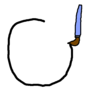 |
This page is about an important IRL ideology "This knowledge is essential to political science!" - Scientocracy This page is about an ideology that not only exists in the real world, but is also of reasonable importance. Please do not make major edits to this page without citing sources, so that it may stay accurate. |
 |
Stub Article "Help" - Still-Being-Drawnism This page is a stub. You can help FreePCB by expanding it. |
![]() Dirigisme or Dirigerism (from French diriger, “to direct”) is an economic system in which the national government plays an imperative role in directing and coordinating the economy through public policy. By utilizing market instruments like taxation and monetary investment, the state is understood to be capable of correcting inefficiency and failures commonly found among tradition free-market economics, while also achieving it's desired material objectives.
Dirigisme or Dirigerism (from French diriger, “to direct”) is an economic system in which the national government plays an imperative role in directing and coordinating the economy through public policy. By utilizing market instruments like taxation and monetary investment, the state is understood to be capable of correcting inefficiency and failures commonly found among tradition free-market economics, while also achieving it's desired material objectives.
Beliefs
Dirigisme is a term that refers to an economic philosophy advocating for active state intervention in the economy to guide and direct a country's economic development. While not a belief system in itself, dirigisme encompasses several beliefs and principles that support its focus on state planning and regulation in the economy. Some of the beliefs associated with dirigisme include:
- Belief in Economic Planning: Dirigisme places importance on planning and coordinating economic activity at the national level. This often involves the formulation of five-year plans or long-term strategies to guide economic development.
- Active Role of the State: Proponents of dirigisme believe that the state should assume an active role in the economy, engaging in regulation, investment, and management of key sectors.
- Promotion of Social Welfare: It is argued that dirigisme aims to promote social welfare through economic policies that emphasize equity and equitable wealth distribution. This often includes welfare policies, minimum wages, and regulations to protect workers and consumers.
- State Control of Strategic Sectors: Within the framework of dirigisme, there is an advocacy for state control or ownership of strategic economic sectors, such as energy, communications, and heavy industry, with the goal of ensuring economic stability and independence.
- Market Regulation: Regulation is considered necessary to prevent unfair business practices and economic crises. Dirigisme may involve price controls, competition regulation, and oversight of financial markets.
- Investment in Infrastructure and Education: Dirigistes believe in public investment in infrastructure and education as a means to stimulate economic growth and enhance productivity.
- Emphasis on Industrialization: Dirigisme is often associated with an industrial development strategy, where the state promotes the expansion of manufacturing and technology to achieve economic self-sufficiency.
- Cooperation between the Public and Private Sectors: Although the state plays a significant role, dirigisme does not necessarily exclude private sector participation in the economy. It may emphasize cooperation and partnership between the public and private sectors.
History
The origins of dirigisme—understood as government action aimed at creating, promoting, or defending a country's industry or economy—can be traced back to the works of monarchs such as Peter the Great of Russia, Joseph I of Portugal, Charles III of Spain, and others associated with absolutism (see: Royal Manufacture). Among them, Louis XIV of France stands out, who, through his finance minister Jean-Baptiste Colbert, transformed what had been the occasional action of some kings into "state policy."
Later on, Henri de Saint-Simon introduced the term itself but generalized and modified the proposal, transforming it from one of the state's objectives into the main goal of the state, which would require a reorganization of it. Saint-Simon envisioned this reorganization of society taking place under the guidance of an elite of philosophers, scientists, and technicians leading a peaceful process of industrialization moderated by a "Christian humanism" - which would have scientists as priests. Saint-Simon did not conceive this as requiring a strong government; instead, he envisioned one based on communities and consensus[1]. In this regard, Saint-Simon's thinking has been considered "progressive" or "socialist."
Subsequently, Auguste Comte adopted the concept (in his "Système de Politique Positive" - 1851), assigning to the government the role of directing individual action toward a common objective. For Comte, this government - contrary to Saint-Simon's suggestion - is authoritarian, as the progressive action of Saint-Simon is no longer based on discussions and agreements but rather on the discovery and application of "natural laws" by the scientific and technical administrators of the state. While in Saint-Simon's conception, scholars guide the community through free argumentation - whose members are free to dissent - in Comte's view, scholars play a primary role in educating through a process that "will give everyone the necessary knowledge to understand their place, their role as an "organ of humanity" through a system that must be "precise in terms of both programs and institutional frameworks," tending to limit individual intervention absolutely... (routinely implementing) administrative research, uniform centralization, regular reassignment of personnel to avoid personal relationships, precise content courses and strict programs, everything is planned and announced in advance[2].
The development of this political concept of dirigisme coincided with the development of meritocracy and bureaucracy as forms of administration, especially public administration. These concepts shaped the reform of the École polytechnique in France (in 1817) and later, the periods of Napoleon III and the Paris Commune, leading to the foundation of several "higher schools" such as the École libre des sciences politiques and eventually (in 1945) the École Nationale d'Administration.
It has been suggested[3] that the proposal is that countries that had not achieved economic development through laissez-faire could develop, strengthen, and expand both industry and the national economy through dirigisme économique.
This position reached its peak in France after World War II with the "dirigisme" of Gaullism, a system through which the country sought not only to repair the immense damage caused by the war but also to expand and modernize both the industrial base and all types of infrastructure in the country.
For example, it has been argued that the pre-war French industry was generally composed of family-owned businesses, often too small, and consequently undercapitalized and lacking modern and efficient capital and organization. They were simply unable to compete internationally. De Gaulle famously illustrated this situation with the rhetorical question, "How can you govern a country which has 246 varieties of cheese...?". Furthermore, much of the modern equipment and machinery had been simply "transferred" to Germany during the occupation and, in general, had been destroyed during the war itself.
The French governments, under the leadership of Gaullism, addressed this situation with the creation of a "Commissariat au plan" ("Commission for the Plan"). Unlike, for example, the system prevailing in the Soviet Union, the French government never sought widespread ownership of businesses or imposed mandatory goals as part of "the plan." In general, this was implemented through the use of incentives.
For instance, the overall goal of the plan was to build an industry capable of competing internationally with both the English and American industries. An essential part of this goal was to have French companies merge into "national champion" or "renowned" conglomerates that could be promoted internationally by the government. At the same time, the state could provide them with financial support, both direct and indirect (e.g., by exclusively buying from French companies). Other forms of indirect financial support included state financing of scientific and technical research and development (including specific industrial projects expected to generate widespread technical development throughout the industry, like the Concorde project), the provision of highly specialized personnel, and more.
The area in which the French government sought a higher level of control - apart from the educational and scientific research system - was the provision of infrastructure and related services. The French government created or owned companies such as the railway company (SNCF), electricity (EDF), the gas company (GDF), the national airline (Air France), nuclear systems and aerospace industries (CNES and Aérospatiale), etc. However, the French state largely left the construction and maintenance of highways and other land routes to the private industry.
The project was highly successful. During the decades from 1945 to 1975, France experienced unprecedented economic growth (averaging 4.5%), coupled with significant demographic growth, competitive integration into an expanding international economy, and the restoration of national pride. This period is known as the "Trente Glorieuses."
During this period, under the right-wing or conservative presidencies of Charles de Gaulle and Georges Pompidou, dirigisme was seen in France as an intermediate approach between the minimal state intervention of the United States and the maximal intervention of the Eastern Bloc.
However, following the 1973 oil crisis, the French Socialist Party, led by François Mitterrand, was elected on promises of increased intervention. Under this government, many banks and industries were nationalized. However, the poor results of these policies forced the abandonment of these attempts in 1983 and the introduction of a policy of "rigueur" (rigor).
Subsequently, during the 2007 election campaign, both Nicolas Sarkozy - who was elected president - and other candidates proposed a return to the dirigiste model. This proposal seemed to gain traction as a result of the 2008 financial crisis, leading President Sarkozy to propose measures in the context of both the crisis and offshoring to "reindustrialize France."
How to Draw

| Color Name | HEX | RGB | |
|---|---|---|---|
| Brown | #824520 | 130, 69, 32 | |
| Black | #141414 | 20, 20, 20 | |
Relations
Friends
 Jacobinism - You carry my ideas so well!
Jacobinism - You carry my ideas so well! State Capitalism - Literally Me!
State Capitalism - Literally Me! Keynesian School - My modern son.
Keynesian School - My modern son. Regulationism - Based!
Regulationism - Based! Protectionism - PROTECT!
Protectionism - PROTECT! Corporatism - You need be a State Capitalist.
Corporatism - You need be a State Capitalist.
Frenemies
 Cameralism - Based state-owned economy, but Disown the monarchy.
Cameralism - Based state-owned economy, but Disown the monarchy. Socialism - Very Based in my opinion, but an economy based on state capitalism is better.
Socialism - Very Based in my opinion, but an economy based on state capitalism is better. Fascism - It's good that you are like me a little, but you are very... militaristic, and very totalitarian.
Fascism - It's good that you are like me a little, but you are very... militaristic, and very totalitarian. Capitalism - You need regulation.
Capitalism - You need regulation.
Enemies
 Market Socialism - Cringe socialism.
Market Socialism - Cringe socialism. Distributism - That is not equality.
Distributism - That is not equality. Anarcho-Communism - STOP CALLING ME SOCIAL-FASCIST!
Anarcho-Communism - STOP CALLING ME SOCIAL-FASCIST! Mutualism - Centralized forces of production do not make me a fascist!
Mutualism - Centralized forces of production do not make me a fascist! Anarcho-Capitalism - Privatization of industry?! And fuck your deregulations, Anarkiddy!
Anarcho-Capitalism - Privatization of industry?! And fuck your deregulations, Anarkiddy! Anarchism - Anarchy?! CRINGE!
Anarchism - Anarchy?! CRINGE!
Gallery
Portraits and Artwork
-
-
Original Portrait.
Further Information
Literature
Wikipedia
References
| | |

